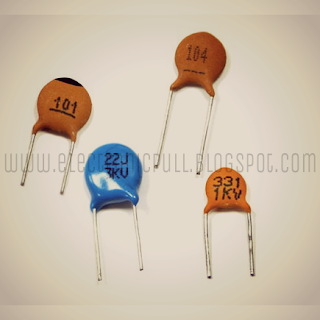Capacitors
Electrical
Electronics
Mini projects
Symbols
Ceramic Capacitors - Introduction and Construction
3:17 PM
Ceramic Capacitors:
These are the non-polarized type of capacitors which are most used capacitors in the electronics. Their name comes from the dielectric, in which ceramic material is used in its construction. Ceramic capacitors are the type of fixed capacitors which are generally very small in both size and capacitance. Their capacitance is usually between picofarads to microfarads (< 10µF). They can be used in both DC and AC circuits.
 |
| Ceramic Capacitors |
Construction of Ceramic Capacitors:
The development of these sorts of capacitors is exceptionally straightforward. A little fired circle is covered with silver on either side. Hence, they are additionally called as Disk Capacitors. The ceramic material functions as dielectric material and the silver covering will form the anodes. The thickness and the structure of the fired layer will decide the electrical properties of the capacitor. To keep vast capacitance values, different layers of such circle disks are stacked to frame a multi-layer clay chip capacitor (MLCC). Present day electronics are formed with the most part that involves MLCC capacitors.
The capacitance of the these type of capacitors is large when contrasted with their size. To achieve large amount of capacitance, the consistent of dielectric these capacitors is high. These type of capacitors are separated into different classes according to their application's areas.
Class 1 Ceramic Capacitors:
Often utilized as a part of resounding circuits on account of their high security and low misfortune. The most widely recognized kind of ceramic material utilized as a part of class 1 capacitor is produced using Titanium dioxide (TiO2) with little parcels of Zinc, Magnesium utilized as extra compounds. Class 1 capacitors have low permittivity and thus the efficiency as far as volume is moderately low. In this way, the capacitance scope of class 1 capacitors is low. The electrical misfortunes of class 1 capacitors are low and the scattering or power dissipition is 0.15 percent. The value of the capacitance is free of the connected voltage. They have a liner temperature coefficient. Every one of these attributes of class 1 ceramic material capacitors make them helpful in the applications such as filter applications with high Q variable and oscillator circuits like PLL's. Class 1 capacitors cannot age after some times.
Class 2 Ceramic Capacitors:
Often utilized as a part of buffers, coupling circuits and by-pass frameworks due to their high productivity as far as volume. This large volume efficiency is a direct result of their high permittivity. The capacitance of class 2 capacitors will rely on upon the connected voltage and has a non-direct change for temperature changes. The exactness and strength are less when contrasted with class 1 ceramic capacitors. The dielectric material for class 2 capacitors is produced using ferroelectric materials like Barium Titanate (BaTiO3) with added substances like silicates of aluminum or magnesium and oxide of aluminum. Due to the high permittivity in class 2 capacitors, high capacitance qualities are conceivable with littler size than class 1 capacitors of same rate of voltage. Henceforth, they are utilized as a part of cradles, channels and coupling circuits where the capacitor is required to keep up a base capacitance. Class 2 capacitors can age after some time.
Class 3 Ceramic Capacitors:
Another class of these capacitors is likewise accessible called Class 3 with higher permittivity and better volumetric effectiveness. In any case, the electrical attributes of this class are more regrettable alongside poor exactness and stability values.
By and large, these capacitors have less ESR (Equivalent arrangement resistance) and leakage electrical current when contrasted with electrolytic capacitors. The working voltage of class 1 fired capacitors is dependent upon 1000V and that in class 2 fired capacitors is dependent upon 2000V. The primary point of interest of ceramic material capacitors is that there are no curls inside its structure thus there is no inductance factor presented during circuit's operation. Henceforth, these type of capacitors are suitable for higher frequencies applications.
The ceramic capacitors are accessible in typical two leaded through-opening structures, surface mount (SMT) multi layer mode and uncommon leadless disc type capacitors that are outlined especially for PCB's. Both the through-gap and surface mount ceramic capacitors are as often as possible utilized. Ceramic capacitors are typically having a 3-digit number coded on their body to recognize the capacitance esteem for the most part in picofarads (pF). In that, the initial two digits are utilized to show the capacitance esteem and the third digit demonstrates the quantity of zeros to be included. For instance an artistic capacitor with the markings 153 would show 15 and 3 zero's in picofarads which is proportional to15, 000 pF or 15nF.





0 comments